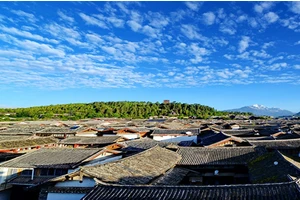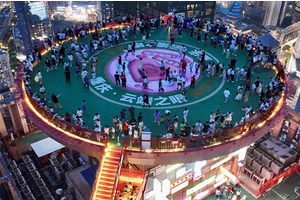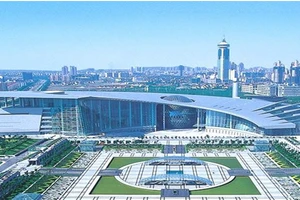Datong Lingqiu Tourism
1. Taohua Mountain is located in the area of Shahumen, Hongshiluan Township, Lingqiu County, Datong City. Spring water rushes down the mountain, and peach blossoms bloom on the mountain. After millions of years of nature, a series of natural karst caves have been formed, mainly peach caves and bat caves. Taohua Cave is located at 1900 meters above sea level in Taohua Mountain. The cave has a history of 1.7 million years, and it is still in the growing period. There are many stalactites in the cave, with different shapes. Some of them are large bead curtains like white jade, some are hanging slowly like a hundred-fold brocade, some are generals in armor, and some are like clusters of fresh mushrooms, which are layered and full of vitality. Peach Fairy, with a peach blossom in hand and a smile on her face, attracts countless young men and women to come here to see the elegant demeanor.
2. The Pingxingguan Dajie Memorial Hall is located on the hillside terrace about one kilometer south of Qiaogou, facing east and west. It is a two-story building with a construction area of 825 square meters, and its name was inscribed by the old general Yang Chengwu. On August 10th, 1986, Marshal Nie Rongzhen wrote a poem to commemorate Pingxingguan's great victory. And the next day, I wrote to Shanxi * and Shanxi *, pointing out that "the victory of Pingxingguan is of great significance and it is necessary to repair the memorial hall." It was rebuilt and expanded in 2007, and reopened on September 27th, 2009, with a total area of 8.5 square kilometers. The overall planning is divided into three axes: the war axis, the memorial axis and the imaginary axis of the beacon tower, 14 scenic spots and 5 functional service areas.
3. The peak of Lingqiu Ancient Road turns around, the river bends, the green hills overlap, and the scenery is charming. Monk Temple, Xiongguan and Buddhist Tombs complement each other. In particular, the Jueshan Temple built in Liao Dynasty is more legendary. The height and depth of the white pagoda and ancient well in the temple are the same as those of the hills next to it, and the number is a mystery, which is called a must. Next to the temple, there is an imperial shooting platform for the Northern Wei Emperor Tuoba Jun to compete with his ministers, and the Monument to the Emperor's Patrol is still discernible. Located in the southeast of Lingqiu County. The ancient road, built in the Northern Wei Dynasty, is the main road leading from the northern Shanxi Plateau to the North China Plain, with a total length of 140 miles from yu zhou in the north to Moyuan in the south.
4. Quhui Temple Stone Tomb is a precious stone carving group site in the Tang Dynasty. Quhui Temple belongs to the lower house of Wutai Mountain. It used to be a Buddhist temple with more than 100 monks. It was renovated in Song, Liao, Yuan, Ming and Qing dynasties. It was burned down by the Japanese army in 1937, and now only the remains of the temple foundation, platform, road and column foundation are left. Stone tombs were built in the tenth year of Tang Tianbao. Historical records record that there are 60 original stone tombs, centered on Quhui Temple and surrounded by mountains, with a total area of about 20 square kilometers. In 1999, Shanxi Institute of Archaeology excavated three. Each stone tomb is in the shape of an earth-rock tomb, covering an area of about 20 square meters, with a height of 3-4 meters and a circumference of about 30 meters. The stone buddhas in the cave are sealed by 112 floors, and the number of Buddha statues varies from 30 to 50.
5. air grassland, located in Liuke Township, Lingqiu County, with an altitude of 2,158 meters, is surrounded by steep slopes, and the top of the mountain is a prairie with an area of 36,000 mu, which is magnanimous, green grass and wild flowers everywhere. Living on it, the sky is like a vault, and the cage covers four fields and is boundless. There is no summer heat in summer, the climate is cool, the mountain flowers are blooming and the grass is green. In autumn, the sky is blue and the grass is blue, and the cattle and sheep are full of mountains. It is a good place to get close to nature and return to nature.
1. Taohua Mountain in Lingqiu, located in Lingqiu County, Datong City, mainly includes Taohua Cave, Bat Cave and other scenic spots. There are many stalactites in the Peach Blossom Cave, with different shapes. Some of them are large bead curtains like white jade, some are hanging slowly like a hundred-fold brocade, some are generals in armor, and some are like clusters of fresh mushrooms, which are layered and full of vitality. The Bat Cave is tall and extends in all directions. Thousands of bats in the cave hang upside down at the top of the cave, like a string of black elves. It is very interesting and is a leisure tourist attraction.
2. Lingqiu Ancient Road, located in the southeast of Lingqiu County, has winding peaks, curved rivers, overlapping green hills and charming scenery. The Buddhist temples, Xiongguan and Buddhist tombs complement each other. In particular, the Jueshan Temple built in Liao Dynasty is more legendary. The white pagoda and ancient well in the temple are the same height and depth as the hills next to it, and the number is a mystery, which is called a must. It is a good place for sightseeing.
3. Quhui Temple Stone Tombs, located in Quhui Temple Village, third floor township, Lingqiu County, is a precious stone carving group site in the Tang Dynasty. Quhui Temple belongs to the lower house of Wutai Mountain. It is a Buddhist temple with more than 100 monks. It has been repaired in Song, Yuan, Ming and Qing dynasties. With Quhui Temple as the center, it is surrounded by mountains, with a total area of about 20 square kilometers. It is a tourist attraction.






